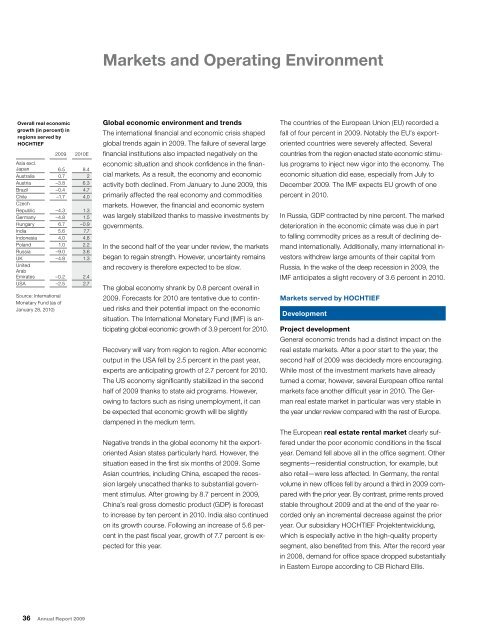ONE ROOF
ONE ROOF
ONE ROOF
You also want an ePaper? Increase the reach of your titles
YUMPU automatically turns print PDFs into web optimized ePapers that Google loves.
Overall real economic<br />
growth (in percent) in<br />
re gions served by<br />
HOCHTIEF<br />
2009 2010E<br />
Asia excl.<br />
Japan<br />
6.5 8.4<br />
Australia 0.7 2<br />
Austria –3.8 6.3<br />
Brazil –0.4 4.7<br />
Chile<br />
Czech<br />
–1.7 4.0<br />
Republic –4.3 1.3<br />
Germany –4.8 1.5<br />
Hungary 6.7 –0.9<br />
India 5.6 7.7<br />
Indonesia 4.0 4.8<br />
Poland 1.0 2.2<br />
Russia –9.0 3.6<br />
UK<br />
United<br />
Arab<br />
–4.8 1.3<br />
Emirates –0.2 2.4<br />
USA –2.5 2.7<br />
Source: International<br />
Monetary Fund (as of<br />
January 28, 2010)<br />
36 Annual Report 2009<br />
Markets and Operating Environment<br />
Global economic environment and trends<br />
The international financial and economic crisis shaped<br />
global trends again in 2009. The failure of several large<br />
financial institutions also impacted negatively on the<br />
economic situation and shook confidence in the financial<br />
markets. As a result, the economy and economic<br />
activity both declined. From January to June 2009, this<br />
primarily affected the real economy and commodities<br />
markets. However, the financial and economic system<br />
was largely stabilized thanks to massive investments by<br />
governments.<br />
In the second half of the year under review, the markets<br />
began to regain strength. However, uncertainty remains<br />
and recovery is therefore expected to be slow.<br />
The global economy shrank by 0.8 percent overall in<br />
2009. Forecasts for 2010 are tentative due to continued<br />
risks and their potential impact on the economic<br />
situation. The International Monetary Fund (IMF) is anticipating<br />
global economic growth of 3.9 percent for 2010.<br />
Recovery will vary from region to region. After economic<br />
output in the USA fell by 2.5 percent in the past year,<br />
experts are anticipating growth of 2.7 percent for 2010.<br />
The US economy significantly stabilized in the second<br />
half of 2009 thanks to state aid programs. However,<br />
owing to factors such as rising unemployment, it can<br />
be expected that economic growth will be slightly<br />
dampened in the medium term.<br />
Negative trends in the global economy hit the export<br />
oriented Asian states particularly hard. However, the<br />
situation eased in the first six months of 2009. Some<br />
Asian countries, including China, escaped the recession<br />
largely unscathed thanks to substantial government<br />
stimulus. After growing by 8.7 percent in 2009,<br />
China’s real gross domestic product (GDP) is forecast<br />
to increase by ten percent in 2010. India also continued<br />
on its growth course. Following an increase of 5.6 percent<br />
in the past fiscal year, growth of 7.7 percent is expected<br />
for this year.<br />
The countries of the European Union (EU) recorded a<br />
fall of four percent in 2009. Notably the EU’s exportoriented<br />
countries were severely affected. Several<br />
countries from the region enacted state economic stimulus<br />
programs to inject new vigor into the economy. The<br />
economic situation did ease, especially from July to<br />
December 2009. The IMF expects EU growth of one<br />
percent in 2010.<br />
In Russia, GDP contracted by nine percent. The marked<br />
deterioration in the economic climate was due in part<br />
to falling commodity prices as a result of declining demand<br />
internationally. Additionally, many international investors<br />
withdrew large amounts of their capital from<br />
Russia. In the wake of the deep recession in 2009, the<br />
IMF anticipates a slight recovery of 3.6 percent in 2010.<br />
Markets served by HOCHTIEF<br />
Development<br />
Project development<br />
General economic trends had a distinct impact on the<br />
real estate markets. After a poor start to the year, the<br />
second half of 2009 was decidedly more encouraging.<br />
While most of the investment markets have already<br />
turned a corner, however, several European office rental<br />
markets face another difficult year in 2010. The German<br />
real estate market in particular was very stable in<br />
the year under review compared with the rest of Europe.<br />
The European real estate rental market clearly suf<br />
fered under the poor economic conditions in the fiscal<br />
year. Demand fell above all in the office segment. Other<br />
segments—residential construction, for example, but<br />
also retail—were less affected. In Germany, the rental<br />
volume in new offices fell by around a third in 2009 compared<br />
with the prior year. By contrast, prime rents proved<br />
stable throughout 2009 and at the end of the year recorded<br />
only an incremental decrease against the prior<br />
year. Our subsidiary HOCHTIEF Projektentwicklung,<br />
which is especially active in the highquality property<br />
segment, also benefited from this. After the record year<br />
in 2008, demand for office space dropped substantially<br />
in Eastern Europe according to CB Richard Ellis.
















